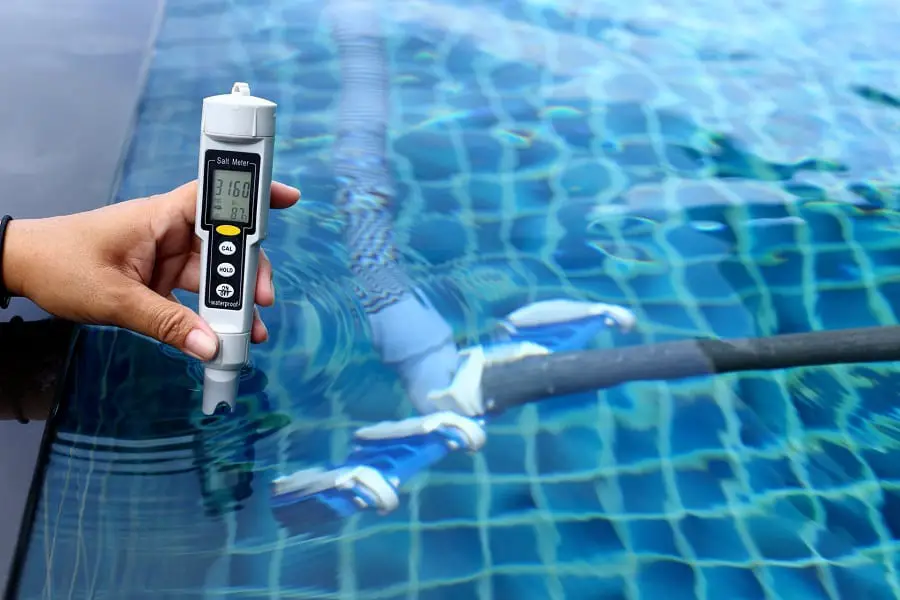Swimming is an excellent activity for people of all ages.
Whether you want an escape from the scorching summer heat or simply want to soothe your aching joints, there is no activity better than swimming.
However, a pool can often be home to several undesirable contaminants, including bacteria and insects. They are not only a health hazard but can also make your swimming experience an unpleasant one.
So how do you keep your swimming pool clean and maintain pool water quality?
We have put together this guide to help address all your concerns about pool water quality so you can get the best pool water in town.
But before we get into the details, it is essential to look at the difference between two major pool maintenance approaches; chlorine pools and saltwater pools, and how their unique features differ from each other.
Contents
Chlorine Pools vs. Salt Water Pools
A sparkling pool where you can relax is like a slice of paradise, but only when you maintain it most appropriately.
Typically, there are two ways of maintaining the water quality of pools; chlorine pools and saltwater pools. And while each of the two methods come with awesome features, it is essential to know the differences.
Chlorine Pools
Perhaps, the most common types of swimming pools are the chlorine pools, and part of the reason is that we are used to it. They are easy to maintain as you can easily find chlorine tablets. Moreover, it is relatively simple to use chlorine tablets for pool maintenance.
All you have to do is add them to the floating disbursement device or into the pool pump unit. Chlorine tablets are effective in eliminating mold and bacterial growth in the water. Furthermore, it is very useful in preventing algae growth in standing pool water.
However, pools that use chlorine for sanitization require a more constant check on the water pH. Since chlorine is only effective in a certain pH range, you need to ensure that the water pH is maintained between 7.2 and 7.6 all the time.
Salt Water Pools
The other approach that is used to maintain the pool water quality is salt chlorinator. Pools, where salt chlorinator is used, are often referred to as saltwater swimming pool.
The salt chlorinator uses salt crystals that are converted into hydrogen gas and water-soluble chlorine through electrolysis. The hydrogen gas escapes from the water but the gaseous chlorine remains in the pool and works on the same principles as chlorine tablets.
In a saltwater pool, you are required to maintain the appropriate levels of salt chlorinator because pool water is often lost due to splashing, evaporation, or drainage.
However, unlike commonly believed, the salt content does not disappear from the pool through water evaporation, and this is precisely why the initial cost is more than chlorine.
And while the initial investment may be expensive, the operation costs are significantly lower when it comes to saltwater pools.
You will be required to invest in a salt chlorinator generator that operates automatically and comes with an operational life of at least five years. However, the equipment requires adequate cleaning and maintenance.
Chlorine Pools or Salt Water Pools – Which One is Better?
Now that you already know about the fundamental differences between a chlorine pool and a saltwater pool, there are a few factors that you need to consider before you choose a particular type of pool.
Some of the factors that you will help you make the right choice include,
Cost
As mentioned earlier, the initial investment for a saltwater pool is typically higher than a chlorine pool.
However, if you look at the operational and maintenance costs, a chlorine pool may be a more expensive choice.
Comfort
Both saltwater pool and chlorine pools have a different feel. A saltwater pool is more comfortable to the skin and eyes and gives you a feeling of swimming in an ocean instead of a pool. However, you may notice the salt residual in the water.
On the other hand, a chlorine pool will always have a distinct smell of the chemical and may irritate skin and eyes.
Chemical Exposure
If swimmers are concerned about chemical exposure, then the saltwater pool is definitely a better choice.
Since salt is a natural product, exposure to this sanitizer is considered safe for people of all ages and skin types. But when it comes to chlorine, its exposure may cause skin and eye irritation.
Landscaping
It is worth noting that saltwater can kill plants and other life forms and completely robs off the soil from nutrients.
Essentials of Pool Maintenance
Maintaining pool water quality can be challenging. After all, different people come in to swim in the pool and bring along various contaminants and bacteria.
Moreover, debris such as dried leaves, dust, and grass may fall into the pool. Lastly, insects and wildlife may drown in your pool and contaminate the water.
All these factors affect the pool water quality and make maintenance essential. Below, you will find out the details of three key elements that will help maintain pool water quality. So let’s get started.
Chlorine Levels
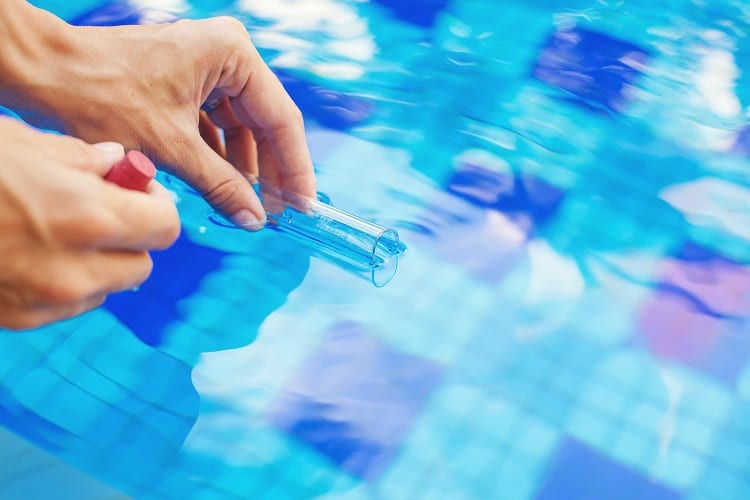
When it comes to maintaining pool water quality, the first thing that comes to mind is chlorine. After all, it is the most widely used chemical to disinfect water and maintain pool hygiene.
However, there are several technical details on measuring it and how frequently you need to treat water using chlorine. In this section, we will highlight them all.
How to Measure it?
Two ways are commonly used to measure the chlorine levels in the pool; the test strips and test kits.
Test Strips
This is the easiest and most convenient way of testing chlorine in the pool. Most residential pool owners rely on this method due to its ease of usage and interpretation.
The chlorine test strips come in small, cylindrical containers with color scales on the container’s outer side. Different colors correspond to other chemicals tested on the strip.
To measure chlorine using a test strip, all you have to do is draw the strip from the container and dip it in pool water. Different test strips come with instructions on how long you will have to hold the strip underwater.
To measure chlorine, you will have to match the appropriate test on the strip with the container’s chlorine color scale. There is likely a variation in the colors, and in that case, it is best to use your judgment for estimating the chlorine content in the pool water.
Test Kits
Test kits are more accurate than test strips and are often used for commercial pools where larger water samples need testing. Therefore, using them is a little complicated.
When you purchase a test kit, it comes with a guide about pool chemistry, along with an instruction manual on how to take the test. Using the provided instructions, take the water sample and add the reagent to test your pool’s chlorine level.
Ensure you only add the recommended amount of water because using inadequate water quantities can significantly impact the reading.
The reagent will activate in the water sample, and the resulting color can be used to compare the color of the water with the scale provided along with the test kit.
Similar to test strips, it is possible that your color may not match with the benchmark. In that case, use your best judgment to estimate the chlorine content in the water.
How Often Should You Treat Your Pool with Chlorine?
Treating your pool with chlorine is an essential aspect of pool maintenance but how often you should do it is a question that needs to be addressed.
According to the Association of Pool and Spa Professionals, the free chlorine level should range between 2.0 and 4.0 ppm. Moreover, the Center for Disease Control (CDC) recommends that the free chlorine levels be above 1.0 ppm for pools and 3.0 ppm for hot tubs.
When you measure the chlorine in your pool and find out the resultant outside these ranges, it’s time to treat your pool with chlorine. But adding the right amount of chlorine may depend on several other reasons, which are highlighted below.
Organic built up in the Pool
When there is organic built up in the pool, a regular dosage of chlorine will not treat your pool. In that case, you will have to shock the pool.
By shocking the pool, you add heavy amounts of chlorine for a short amount of time to raise the level of free chlorine in the water, killing the bacteria and sanitizing water.
Water pH Level
Another major factor that affects the amount of chlorine you should add in your pool is the pH level. In case the water pH is too high, adding chlorine will not disinfect the water.
Moreover, the chlorine will be ineffective in acidic water as well. Therefore, before you add chlorine to treat the water, make sure the pool water pH ranges between 7.2 and 7.6.
Regardless of how frequently you treat the pool water with chlorine, you need to ensure that the pool water’s free chlorine level should stay between 1.0 and 3.0 ppm.
Anything beyond this might increase the risk of skin and eye irritations. Free chlorine level below 1.0 ppm runs swimmers into the risk of several other health conditions due to unhygienic pool conditions.
How to Treat Water with Chlorine?
Pool chlorine is readily available as tablets or sticks that can be easily placed over automatic feeders or floating feeders.
Once you introduce a chlorine tablet, it will gradually dissolve at an even rate. Most pool owners prefer automatic chlorine feeders because they are simple to use and give more control over the amount of chlorine you add to the pool.
Adding an adequate amount of the chlorine in the pool may require some math, but perhaps every formula requires you to know the volume of water you intend to treat.
Once you know the volume, use the following measure. For every 75,000 gallons, you can get a one ppm free chlorine if you add an ounce of chlorine.
Again, to ensure that you add the right amount of chlorine in your pool, make sure you keep a check on the pH levels and your pool’s overall hygiene conditions.
Moreover, it is important to keep in mind that several factors such as UV exposure to pool water, the number of pool users, and the amount of debris can all deteriorate the level of free chlorine in the pool.
Therefore, it is best to check the pool’s pH value along with the status of the chlorine tablets in the water. In case the tablet has dissolved completely, it is best to add another chlorine tablet.
pH Levels of Water in Your Pool
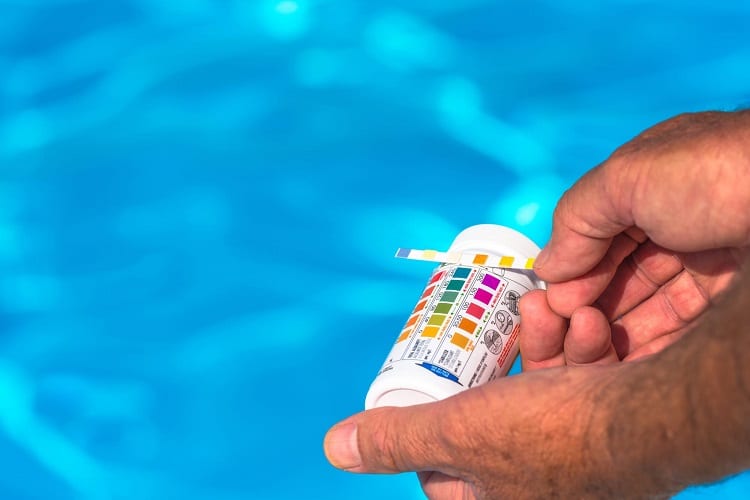
Another critical consideration when it comes to maintaining pool water quality is the pH of water.
pH refers to the acidic or basic inclination of water. Maintaining the pH value is essential in pools because it can significantly affect chlorine effectiveness for pool sanitization.
Chemically, pH is measured on a scale from O to 14, with 7 being neutral. With lower side indicating acidity, whereas the higher side of the scale resonated with alkalic properties.
As the value approaches 7, both acidic and basic properties tend to neutralize. Here, it is important to note that alkaline should not be confused with the pool water’s total alkalinity. While pH and total alkalinity are different, one may be the other and vice versa.
Ideally, the pool water pH should be maintained within the range of 7.2 to 7.6. Pool water with a pH of less than 7.2 can be corrosive to the pool structure and equipment. It also negatively impacts the ability of chlorine to disinfect water.
In case of acidic water, you will need larger quantities of chlorine than would be used at normal pH levels. On the other hand, with a pH higher than 7.8, you are more likely to have scaly or cloudy water.
When the water pH is higher, it affects the water solubility of calcium, resulting in scales and cloudiness of water. Moreover, a higher pH also affects the effectiveness of chlorine for pool sanitization.
What is the Optimal pH Level for Chlorine/Salt Water Pools?
As mentioned earlier, the pool water’s pH should be maintained within the range of 7.2 and 7.8. It is best for chlorine pools to have a pH of 7.4 which ensures perfect sanitization while being gentle of human eyes and skin.
On the other hand, it is best for saltwater pools to have a slightly higher pH of 7.6. Since saltwater pools use salt chlorinators, the pH is on a slightly higher side.
Water Hardness
Now the third most critical essentials of pool maintenance are water hardness. It is a measure of how much calcium carbonate is present in your swimming pool water.
In case of excessive calcium in pool water, you will notice a white, scaly build-up, and perhaps the most crucial reason for calcium is a higher pH of pool water. Moreover, fluctuating temperatures and water evaporation from the pool can also impact water hardness.
Fortunately, water hardness does not change drastically, but even then, it is recommended to test water hardness once a month.
How to Measure it?
You can measure your pool water’s hardness by simply performing a dip test using a water hardness test kit.
You can also use a test strip but just like testing for chlorine, using a test kit is much more accurate and comes with complete instructions on how to use it.
Test Strip
To test your pool water hardness using a test strip, all you have to do is dip the test strip 18 inches below the surface of pool water or as directed by the test strip’s instructions.
Now remove the strip from the water and wait for the color to change, indicating the level of water hardness.
Test Kit
Using a test kit is slightly more complicated compared to using a test strip. It requires filling out the recommended volume of water, followed by the addition of a reagent.
The test kit comes with an instruction manual that guides about how to proceed with the test. When you accurately follow the instructions, you will find out the exact water hardness.
Ideally, water hardness should be between 200 and 400 ppm. In case your test results do not fall into this range, you will have to treat your pool for water hardness.
How to Soften Water in Your Pool?
Adjusting pool water hardness is perhaps the most straightforward aspect of pool maintenance. All you have to do is drain a particular portion of your pool water and fill it up with fresh water.
And when you purchase freshwater for your pool, it is likely to be treated beforehand, so it becomes even easier to fix the chemistry of your pool.
In case you cannot replace your pool water, you can also consider the option of adding commercial water hardness reducers to soften your pool water. Make sure you follow the instructions that come with the commercial products available for treating hard water.
Moreover, to enhance the treatment’s effectiveness, it is best to increase the water pH to 7.8 to 8.2 right after the treatment.
Continue with the higher pH pool water for up to five days and repeat the water hardness test seven days after the treatment. In case water hardness is still an issue, you will need to repeat the treatment.
How Often Should You Change Water in Your Pool?
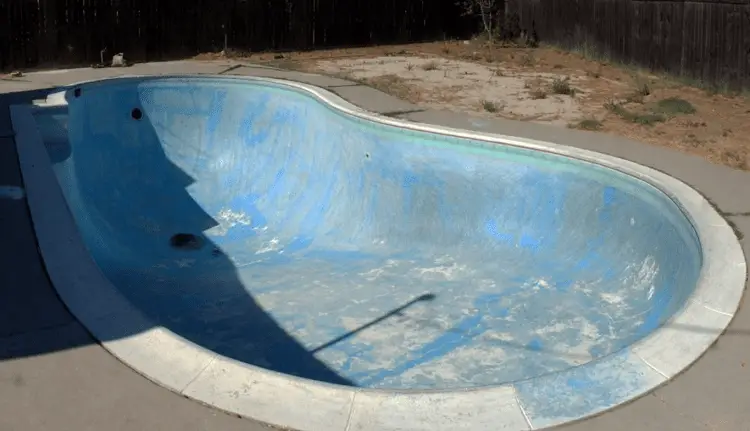
The million-dollar question when it comes to pool maintenance is how often should you change the pool water.
Unfortunately, there is no single answer to this question. How often you should change the water depends on the number of pool users, climate, water hardness, and the frequency of overall pool maintenance.
For a residential swimming pool, experts recommend changing the water once every five to seven years; however, in a commercial facility, you may need to change pool water anywhere between three months to three years.
Pool water that has not been replaced for too long in a pool is not maintained can damage the pool’s surface. The problem is worse in case the water is too hard.
An important thing to remember is that a pool can significantly lose water due to evaporation, splashing, and swimmers leaving the pool. Therefore, it is best to substitute this water loss continuously.
How to Sanitize Your Pool?
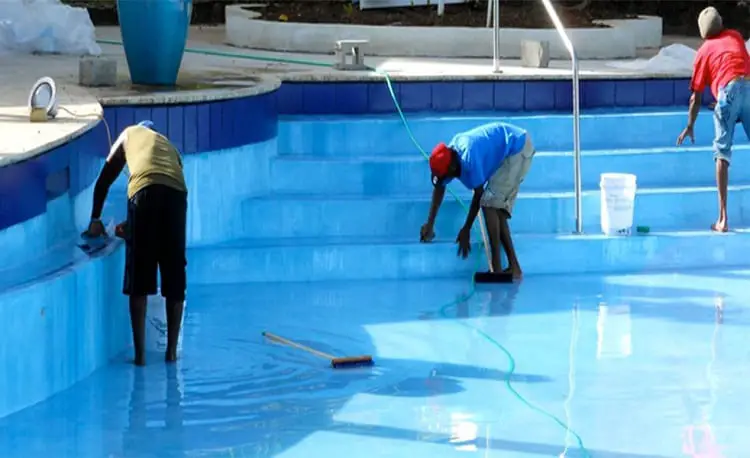
Almost all aspects of pool maintenance revolve around pool sanitization i.e., keeping it free from all harmful bacteria and pathogens that can cause health concerns for swimmers.
An added advantage of pool sanitization is that the water remains crystal clear, and this can greatly enhance the swimming experience.
And while chlorine treatment is known to be the best and most popular way to sanitize the pool, there are several other sanitation methods that you can use to keep your pool clean. Let’s take a look at each method.
Chlorine Treatment
Chlorine treatment is the most popular method of pool sanitation that involves hypochlorous acid that effectively kills bacteria and pathogens such as E.Coli.
Moreover, it is effective against all harmful chemicals that swimmers bring along in the water from the environment. And lastly, it is an excellent way of keeping algae out of the pool.
Salt Sanitizer
Another sanitation approach that has gained popularity in the last few years is saltwater sanitizers.
It is gradually replacing off-the-shelf chlorine tablets for treating pool water because here, you can use a generator that converts salt into water-soluble chlorine gas that is as effective as chlorine tablets.
However, a distinguishing feature is how the two methods are different when it comes to the feel of water. With salt sanitizer, you get a better feel that is similar to swimming in an ocean without any unpleasant chlorine smell.
Bromine Treatment
Similar to chlorine, bromine is also an effective pool sanitizer. However, it is slightly more expensive.
While chlorine is better at effectively changing the contaminants’ chemical structure in the water, bromine is gentler on the skin and eyes and does not come with a strong, unpleasant smell.
Moreover, it is more stable in warm water; therefore, it is an excellent choice for hot tubs and spas but can also be used in swimming pools.
Ozone Pool Purification
An effective, FDA approved water sanitation method is ozone purification. It involves using “triatomic oxygen,” or O3, that can effectively destroy microorganisms while reducing the accumulation of deposits in the pool and water system.
Since it does not involve the use of chemicals, it is extremely mild on the pool water and swimmers. However, it is a slightly more expensive technology for cleaning the pool.
Ultraviolet Pool Sanitizing Light
Another powerful disinfection method is ultraviolet sanitation that relies on the use of short-wavelength UV light (UV-C) to kill bacteria or other microorganisms. UV light is not only effective against pathogens but works equally well for algae.
There are other lesser-known methods of pool sanitation, including pool ionizers and the use of hydrogen peroxide. Different sanitation methods have varying effectiveness based on the pool placement (whether it is indoor or outdoor) and the kind of pathogen that you want to destroy.
Moreover, it is important to remember that each sanitation method comes with its own set of pros and cons that you need to consider before you make a choice.
Therefore, it is best to complete your research before you choose the sanitation method for your pool. In case you are not sure, don’t forget to consult with a professional before selecting a sanitation system or switching to a new one.
Taking Care of Pool Water Quality
Now that’s a wrap for everything you should know about maintaining pool water quality.
From covering different aspects of pool maintenance to finding out answers to questions such as how often should you change the pool water and pool sanitation methods, we have covered it all.
Hopefully, you would have learned several new things that can ease your journey on the road to taking care of your pool and maintaining pool water quality.
An important thing to remember is that pool maintenance may not be tough, but it is certainly something that you need to do on a regular basis. Only then, you can enjoy your leisure time in a clear sparkling pool forever.

